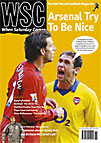 Neil White on the pros and cons of UEFA's plans for football's future pitches
Neil White on the pros and cons of UEFA's plans for football's future pitches
When an irate Gerry Collins launched into a vitriolic rant at a post-match press conference last week, it had nothing to do with his Partick Thistle side’s insipid performance in their defeat by Dunfermline. Collins’ ire was directed exclusively at Dunfermline Athletic’s new artificial pitch – UEFA’s view of football’s future.
“The pitch is a disgrace,” said Collins after his side lost 2-1 on the third match to be played on the plastic. “Are we the guinea pigs of Europe now or what? It takes away the art of tackling. I’ve got players complaining of tight calves and burns on their arses. If you’re going to experiment, do it at amateur or juvenile level. Play hockey on that surface, fine. But not SPL football.”
Two decades on from the ill-fated plastic revolution that saw artificial pitches at Queens Park Rangers and Luton routinely blamed for poor football and an increase in injuries, UEFA have launched a series of tests for their new XL Turf, with Dunfermline spearheading the two-year experiment. As part of the partnership, UEFA installed and paid for the new surface at East End Park and Dunfermline received a substantial fee for their trouble. And that’s some trouble. The Pars’ plastic has proved explosive.
Collins was not the first to have a dig, although there are those who welcome a guaranteed antidote to the fixture-busting Scottish winter. The XL Turf means no postponements and the pitch can be used seven days a week for commercial and community purposes. For a club such as Dunfermline, who have worked tirelessly to establish themselves in the top flight, to ignore such an opportunity would be financial folly.
“It’s definitely the way forward,” said Pars manager Jimmy Calderwood. “I played on the plastic at QPR and it was terrible, but this is by far the best artificial pitch that I’ve seen.” He is a rarity, a football man willing to speak out in favour of the new pitch. Its other advocates tend to be chairmen, administrators and the odd bank manager of cash-strapped clubs. Perhaps he is just toeing the party line, or maybe he sees a potential benefit on the pitch as well as off it.
Calderwood played and managed in Holland before returning to his native Scotland. He has spent the past few years converting Dunfermline from a route-one philosophy to something approaching total football, or the Fife equivalent thereof. The true, fast-running surface Dunfermline now play half of their fixtures on is well suited to their game and they get to train on it every week. Surely, over time, a massive advantage.
Collins, in his own spitfire way, summed up the misgivings most people in Scottish football have about the Pars’ synthetic surface. It changes the rules, for defenders at least. But the painful consequence of a sliding tackle is not the only physical concern for players.
The SFA’ s director of physiotherapy, Jim Fallon, is convinced that the plastic will take its toll on players. He said: “The surface could lead to long-term damage, with pelvic and knee problems the most prominent concern. On other artificial parks, we see that falls are more regular and knee injuries occur when players are unable to turn. Although it takes away a lot of the physical contact as slide tackles go out of the window, the bigger picture is a worry.”
“I’d like to see what Martin [O’Neill] and Big Alex [McLeish] have to say when they come here,” said Collins. If the plastic costs either half of the Old Firm a million-pound player when they come to town, UEFA’s latest experiment could spawn a headache for Dunfermline.
From WSC 201 November 2003. What was happening this month